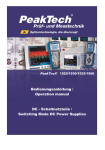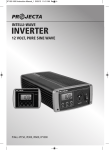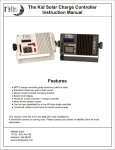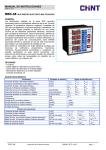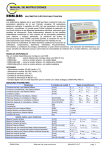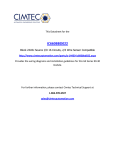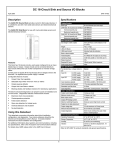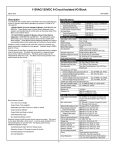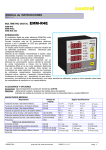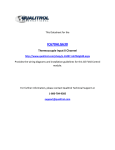Download Schumacher Electric DY-1420 Owner`s manual
Transcript
OWNER’S MANUAL Model: DY-1420 Manual Battery Charger Voltage: 12 Amperage: 2, 20, 55 DO NOT RETURN THIS PRODUCT TO THE STORE! Call Customer Service for Assistance: 800-621-5485 READ THE ENTIRE MANUAL BEFORE USING THIS PRODUCT. FAILURE TO DO SO COULD RESULT IN SERIOUS INJURY OR DEATH. use el cargador de baterías hasta que haya leído y comprendido PELIGRO NO completamente el manual del usuario. Si usted desea una versión en español de esta edición, visite nuestra página en la red localizada en www.batterychargers. com así podrá obtener un instructivo del cargador de baterías en español. Si usted no tiene acceso a la red y necesita asistencia, llame Servicios al Cliente al (800) 621-5485. 0099001066-01 IMPORTANT: READ AND SAVE THIS SAFETY AND INSTRUCTION MANUAL. SAVE THESE INSTRUCTIONS – This manual will show you how to use your charger safely and effectively. Please read, understand and follow these instructions and precautions carefully, as this manual contains important safety and operating instructions. The safety messages used throughout this manual contain a signal word, a message and an icon. The signal word indicates the level of the hazard in a situation. Indicates an imminently hazardous situation which, if not avoided, will result in death or serious injury to the operator or bystanders. Indicates a potentially hazardous situation which, if not avoided, could result in death or serious injury to the operator or bystanders. Indicates a potentially hazardous situation which, if not avoided, could result in moderate or minor injury to the operator or bystanders. Indicates a potentially hazardous situation which, if not avoided, could result in damage to the equipment or vehicle or property damage. Pursuant to California Proposition 65, this product contains chemicals known to the State of California to cause cancer and birth defects or other reproductive harm. 1. 1.4 1.5 1.6 1.7 1.8 1.9 IMPORTANT SAFETY INSTRUCTIONS – SAVE THESE INSTRUCTIONS This manual contains important safety and operating instructions RISK OF ELECTRIC SHOCK OR FIRE. 1.1 Keep out of reach of children. 1.2 Do not expose the charger to rain or snow. 1.3 Use only recommended attachments. Use of an attachment not recommended or sold by Schumacher® Electric Corporation may result in a risk of fire, electric shock or injury to persons or damage to property. To reduce the risk of damage to the electric plug or cord, pull by the plug rather than the cord when disconnecting the charger. An extension cord should not be used unless absolutely necessary. Use of an improper extension cord could result in a risk of fire and electric shock. If an extension cord must be used, make sure: • That the pins on the plug of the extension cord are the same number, size and shape as those of the plug on the charger. • That the extension cord is properly wired and in good electrical condition. • That the wire size is large enough for the AC ampere rating of the charger as specified in section 8. To reduce the risk of electric shock, unplug the charger from the outlet before attempting any maintenance or cleaning. Simply turning off the controls will not reduce this risk. Do not operate the charger with a damaged cord or plug; have the cord or plug replaced immediately by a qualified service person. (Call customer service at: 1-800-621-5485.) Do not operate the charger if it has received a sharp blow, been dropped or otherwise damaged in any way; take it to a qualified service person. (Call customer service at: 1-800-621-5485.) Do not disassemble the charger; take it to a qualified service person when service or repair is required. Incorrect reassembly may result in a risk of fire or electric shock. (Call customer service at: 1-800-621-5485.) •1• 1.11 2. RISK OF EXPLOSIVE GASES. 1.10 WORKING IN THE VICINITY OF A LEAD-ACID BATTERY IS DANGEROUS. BATTERIES GENERATE EXPLOSIVE GASES DURING NORMAL BATTERY OPERATION. FOR THIS REASON, IT IS OF UTMOST IMPORTANCE THAT YOU FOLLOW THE INSTRUCTIONS EACH TIME YOU USE THE CHARGER. To reduce the risk of a battery explosion, follow these instructions and those published by the battery manufacturer and the manufacturer of any equipment you intend to use in the vicinity of the battery. Review the cautionary markings on these products and on the engine. PERSONAL PRECAUTIONS RISK OF EXPLOSIVE GASES. 2.1 NEVER smoke or allow a spark or flame in the vicinity of a battery or engine. 2.2 Remove personal metal items such as rings, bracelets, necklaces and watches when working with a lead-acid battery. A lead-acid battery can produce a short-circuit current high enough to weld a ring or the like to metal, causing a severe burn. 2.3 Be extra cautious to reduce the risk of dropping a metal tool onto the battery. It might spark or short-circuit the battery or other electrical part that may cause an explosion. 2.4 Use this charger for charging LEAD-ACID batteries only. It is not intended to supply power to a low voltage electrical system other than in a starter-motor application. Do not use this battery charger for charging dry-cell batteries that are commonly used with home appliances. These batteries may burst and cause injury to persons and damage to property. 2.5 NEVER charge a frozen battery. 2.6 NEVER overcharge a battery. 2.7 Consider having someone close enough by to come to your aid when you work near a lead-acid battery. 2.8 Have plenty of fresh water and soap nearby in case battery acid contacts your skin, clothing or eyes. 2.9 Wear complete eye and body protection, including safety goggles and protective clothing. Avoid touching your eyes while working near the battery. 2.10 If battery acid contacts your skin or clothing, immediately wash the area with soap and water. If acid enters your eye, immediately flood the eye with cold running water for at least 10 minutes and get medical attention right away. 2.11 If battery acid is accidentally swallowed, drink milk, the whites of eggs or water. DO NOT induce vomiting. Seek medical attention immediately. 3. 3.3 3.4 3.5 PREPARING TO CHARGE RISK OF CONTACT WITH BATTERY ACID. BATTERY ACID IS A HIGHLY CORROSIVE SULFURIC ACID. 3.1 If it is necessary to remove the battery from the vehicle to charge it, always remove the grounded terminal first. Make sure all of the accessories in the vehicle are off to prevent arcing. 3.2 Be sure the area around the battery is well ventilated while the battery is being charged. Clean the battery terminals before charging the battery. During cleaning, keep airborne corrosion from coming into contact with your eyes, nose and mouth. Use baking soda and water to neutralize the battery acid and help eliminate airborne corrosion. Do not touch your eyes, nose or mouth. Add distilled water to each cell until the battery acid reaches the level specified by the battery manufacturer. Do not overfill. For a battery without removable cell caps, such as valve regulated lead acid batteries (VRLA), carefully follow the manufacturer’s recharging instructions. Read, understand and follow all instructions for the charger, battery, vehicle and any equipment used near the battery and charger. Study all of the battery manufacturer’s specific precautions while charging and recommended rates of charge. •2• 3.6 3.7 4. 4.3 4.4 4.5 5. 5.1 5.2 6. 6.2 6.3 6.4 6.5 6.6 6.7 6.8 6.9 Determine the voltage of the battery by referring to the vehicle owner’s manual and make sure that the output voltage selector switch is set to the correct voltage. If the charger has an adjustable charge rate, charge the battery in the lowest rate first. Make sure that the charger cable clips make tight connections. CHARGER LOCATION RISK OF EXPLOSION AND CONTACT WITH BATTERY ACID. 4.1 Locate the charger as far away from the battery as the DC cables permit. 4.2 Never place the charger directly above the battery being charged; gases from the battery will corrode and damage the charger. Do not set the battery on top of the charger. Never allow battery acid to drip onto the charger when reading the electrolyte specific gravity or filling the battery. Do not operate the charger in a closed-in area or restrict the ventilation in any way. DC CONNECTION PRECAUTIONS Connect and disconnect the DC output clips only after setting all of the charger switches to the “off” position (if applicable) and removing the AC plug from the electrical outlet. Never allow the clips to touch each other. Attach the clips to the battery and chassis, as indicated in sections 6 and 7. FOLLOW THESE STEPS WHEN BATTERY IS INSTALLED IN VEHICLE A SPARK NEAR THE BATTERY MAY CAUSE A BATTERY EXPLOSION. TO REDUCE THE RISK OF A SPARK NEAR THE BATTERY: 6.1 Position the AC and DC cables to reduce the risk of damage by the hood, door and moving or hot engine parts. NOTE: If it is necessary to close the hood during the charging process, ensure that the hood does not touch the metal part of the battery clips or cut the insulation of the cables. Stay clear of fan blades, belts, pulleys and other parts that can cause injury. Check the polarity of the battery posts. The POSITIVE (POS, P, +) battery post usually has a larger diameter then the NEGATIVE (NEG, N, -) post. Determine which post of the battery is grounded (connected) to the chassis. If the negative post is grounded to the chassis (as in most vehicles), see step 6.5. If the positive post is grounded to the chassis, see step 6.6. For a negative-grounded vehicle, connect the POSITIVE (RED) clip from the battery charger to the POSITIVE (POS, P, +) ungrounded post of the battery. Connect the NEGATIVE (BLACK) clip to the vehicle chassis or engine block away from the battery. Do not connect the clip to the carburetor, fuel lines or sheet-metal body parts. Connect to a heavy gauge metal part of the frame or engine block. For a positive-grounded vehicle, connect the NEGATIVE (BLACK) clip from the battery charger to the NEGATIVE (NEG, N, -) ungrounded post of the battery. Connect the POSITIVE (RED) clip to the vehicle chassis or engine block away from the battery. Do not connect the clip to the carburetor, fuel lines or sheet-metal body parts. Connect to a heavy gauge metal part of the frame or engine block. Connect charger AC supply cord to electrical outlet. When disconnecting the charger, turn all switches to off, disconnect the AC cord, remove the clip from the vehicle chassis and then remove the clip from the battery terminal. See CALCULATING CHARGE TIME for length of charge information. •3• 7. 7.2 7.3 7.4 7.5 7.6 7.7 7.8 8. FOLLOW THESE STEPS WHEN BATTERY IS OUTSIDE VEHICLE A SPARK NEAR THE BATTERY MAY CAUSE A BATTERY EXPLOSION. TO REDUCE THE RISK OF A SPARK NEAR THE BATTERY: 7.1 Check the polarity of the battery posts. The POSITIVE (POS, P, +) battery post usually has a larger diameter than the NEGATIVE (NEG, N, -) post. Attach at least a 24-inch (61 cm) long 6-gauge (AWG) insulated battery cable to the NEGATIVE (NEG, N, -) battery post. Connect the POSITIVE (RED) charger clip to the POSITIVE (POS, P, +) post of the battery. Position yourself and the free end of the cable you previously attached to the NEGATIVE (NEG, N, -) battery post as far away from the battery as possible – then connect the NEGATIVE (BLACK) charger clip to the free end of the cable. Do not face the battery when making the final connection. Connect charger AC supply cord to electrical outlet. When disconnecting the charger, always do so in the reverse order of the connecting procedure and break the first connection while as far away from the battery as practical. A marine (boat) battery must be removed and charged on shore. To charge it onboard requires equipment specially designed for marine use. Grounding and AC power cord connections RISK OF ELECTRIC SHOCK OR FIRE. 8.1 This battery charger is for use on a nominal 120-volt circuit and has a grounded plug that looks like the plug illustrated. The charger must be grounded to reduce the risk of electric shock. The plug must be plugged into an outlet that is properly installed and grounded in accordance with all local codes and ordinances. The plug pins must fit the receptacle (outlet). Do not use with an ungrounded system. 8.2 8.3 9. 9.1 Never alter the AC cord or plug provided – if it does not fit the outlet, have a proper grounded outlet installed by a qualified electrician. An improper connection can result in a risk of an electric shock or electrocution. NOTE: Pursuant to Canadian Regulations, use of an adapter plug is not allowed in Canada. Use of an adapter plug in the United States is not recommended and should not be used. Recommended minimum AWG size for extension cord: • 100 feet (30.5 meters) long or less – use a 10 gauge (5.26mm2) extension cord. • Over 100 feet (30.5 meters) long – use an 8 gauge (8.36mm2) extension cord. ASSEMBLY INSTRUCTIONS It is important to fully assemble your charger before use. Remove all cord wraps and uncoil the cables prior to using the battery charger. Follow these instructions for assembly. PARTS TOOLS NEEDED (2) 10-32, thread cutting screws 3/8" wrench (for mounting foot) (4) ¼-20, thread cutting screws 5/16" wrench (for mounting wheels) (2) wheels 1/4" wrench (for mounting handle) (1) axle hammer (2) axle caps screwdriver (flat blade) (2) axle brackets screwdriver (Phillips) (1) handle (1) foot •4• 9.2 Attach the Foot: Remove the charger from the packing materials and place upside down on a flat surface. Attach the foot and secure it with the four ¼-20 thread cutting screws provided. 9.3 Assemble the Wheels and Axle: Hold the axle upright on the floor or work surface. Then, using a hammer, tap one of the axle caps onto the top end of the axle. Be sure to tap the axle cap on straight. Slide both wheels onto the axle with the recessed hubs facing out as shown. Install the second axle cap. 9.4 Mount the Axle to the Charger: Place one end of each bracket into the slot on the bottom of the charger. Place the axle assembly under each bracket. Attach the brackets using the two, 10-32 thread cutting screws provided. NOTE: Be careful not to drop the brackets inside of the charger case. 9.5 10. Attach the Handle: Turn the charger right side up onto its foot and wheels. Remove the two top screws from each side of the charger. Align the handle so the screw holes are aligned with the screw holes on each side of the charger. Attach the handle using the same screws you previously removed. CONTROL PANEL Ammeter The Ammeter indicates the amount of current, measured in amps, that is being drawn by the battery. As a battery takes on a charge, it draws less current from the charger. Correspondingly, the meter will show less current being drawn by the battery. When the current stops decreasing, the battery is charged. The start area of the meter indicates a high rate of current being drawn from the charger. When cranking an engine, the meter needle will be at the extreme right side of the start area. The 2 amp charge rate may indicate some activity on the meter, although the meter does not have the resolution to display this low rate. Charge Rate Selector Switch Use the Charge Rate selector switch to select the charge rate or engine starting setting you require. • Switch #1 - Use this switch to select the 55 Amp Charge Rate ↔ 140 Amp Engine Start and the 20 Amp Charge Rate. Switch #2 must be in the down position (Select Position) when using Switch #1. • Switch #2 - Use this switch to select the 2 amp Charge Rate and the OFF position. Also, use to select use of Switch #1. Note that Switch #1 is only effective when Switch #2 is set to “Select Position.” • 2A Slow Charge Rate – Intended for charging small batteries such as those commonly used in garden tractors, snowmobiles and motorcycles. •5• • 20A Rapid and 55A Boost Charge Rate – Use for charging automotive, marine and deep-cycle batteries. Not intended for industrial applications. • 140A Engine Start – Provides 140 amps for cranking an engine with a weak or run down battery. Always use in combination with a battery. 11. OPERATING INSTRUCTIONS This battery charger must be properly assembled in accordance with the assembly instructions before it is used. This is a manual charger. Be sure to monitor the charging process and stop it when the battery is charged. Not doing so may cause damage to your battery or result in other property damage or personal injury. Charging 1. Ensure that all of the charger components are in place and in good working condition, for example, the plastic boots on the battery clips. 2. Connect the battery following the precautions listed in sections 6 and 7. 3. Connect the AC power following the precautions listed in section 8. 4. Select the appropriate settings for your battery. 5. Turn the charger on. Manual Charging Mode When a manual charge is performed, the charger will continue to charge and will not shut off. You must keep a visual check on the ammeter to determine when the battery is charged. Be sure to monitor the charging process and stop it when the battery is charged. Not doing so may cause damage to your battery or result in other property damage or personal injury. Using the Engine Start feature Your battery charger can be used to jumpstart your car if the battery is low. Follow these instructions on how to use the ENGINE START feature. Follow all safety instructions and precautions for charging your battery. Wear complete eye protection and clothing protection. Charge your battery in a wellventilated area. Using the ENGINE START feature WITHOUT a battery installed in the vehicle could cause damage to the vehicle’s electrical system. NOTE: If you have charged the battery and it still will not start your car, do not use the engine start feature, or it could damage the vehicle’s electrical system. 1. Set switch #2 to the OFF position. 2. With the charger unplugged from the AC outlet, connect the charger to the battery following the instructions given in section 6 (FOLLOW THESE STEPS WHEN THE BATTERY IS INSTALLED IN A VEHICLE). 3. Plug the charger AC power cord into the AC outlet. 4. With the charger plugged in and connected to the battery of the vehicle, set switch #1 to the engine start position, and set switch #2 to the down position. 5. Crank the engine until it starts or 3 seconds pass. If the engine does not start, wait 6 minutes before cranking again. This allows the charger and battery to cool down. NOTE: During extremely cold weather, or if the battery is under 2 volts, charge the battery for 5 minutes before cranking the engine. 6. If the engine fails to start, charge the battery for 5 more minutes before attempting to crank the engine again. 7. After the engine starts, move switch #2 to the OFF position and unplug the AC power cord before disconnecting the battery clips from the vehicle. 8. Clean and store the charger in a dry location. NOTE: If the engine does turn over but never starts, there is not a problem with the starting system; there is a problem somewhere else with the vehicle. STOP cranking the engine until the other problem has been diagnosed and corrected. •6• 12. CALCULATING CHARGE TIME Find your battery’s rating on the chart below, and note the charge time given for each charger setting. The times given are for batteries with a 50% charge prior to recharging. Add more time for severely discharged batteries. NR means that the charger setting is NOT RECOMMENDED. CHARGE RATE/CHARGING TIME BATTERY SIZE/RATING SMALL BATTERIES 2 AMP 20 AMP 55 AMP 6 - 12 AH 2 – 3¾ hrs NR NR 12 - 32 AH 3¾ – 10 hrs NR NR 40 - 60 RC 11¼ – 14½ hrs 1 – 1½ hrs 25 - 32 min 315 - 550 CCA 60 - 85 RC NR 1½ – 2 hrs 32 - 40 min 550 - 1000 CCA 80 - 190 RC NR 2 – 3½ hrs 40 - 76 min 80 RC NR 1¾ hrs NR 140 RC NR 2¾ hrs NR 160 RC NR 3 hrs NR 180 RC NR 3¼ hrs NR Motorcycle, garden, tractor, etc. 200 - 315 CCA CARS/TRUCKS MARINE/DEEP CYCLE 13. MAINTENANCE INSTRUCTIONS 13.1 After use and before performing maintenance, unplug and disconnect the battery charger (see sections 6, 7 and 8). 13.2 Use a dry cloth to wipe all battery corrosion and other dirt or oil from the battery clips, cords, and the charger case. 13.3 Ensure that all of the charger components are in place and in good working condition, for example, the plastic boots on the battery clips. 13.4 Servicing does not require opening the unit, as there are no user-serviceable parts inside. 13.5 All other servicing should be performed by qualified service personal. 14. Moving and STORAGE INSTRUCTIONS 14.1 Store the charger unplugged, in an upright position. The cord will still conduct electricity until it is unplugged from the outlet. 14.2 Store inside, in a cool, dry place. 14.3 Do not store the clips on the handle, clipped together, on or around metal, or clipped to the cables. 14.4 If the charger is moved around the shop or transported to another location, take care to avoid/prevent damage to the cords, clips and charger. Failure to do so could result in personal injury or property damage. 15. TROUBLESHOOTING PROBLEM Charger will not turn on when properly connected. The battery is connected and the charger is on, but is not charging. POSSIBLE CAUSE REASON/SOLUTION AC outlet is dead. Check for open fuse or circuit breaker supplying AC outlet. Poor electrical connection. Check power cord and extension cord for loose fitting plug. Clips are not making a good connection. Check for poor connection at battery and frame. Make sure connecting points are clean. Rock clips back and forth for a better connection. •7• PROBLEM No reading on the ammeter. Ammeter reading stays high. POSSIBLE CAUSE Charger is not plugged in. Plug the charger into an AC outlet. No power at the receptacle. Check for open fuse or circuit breaker supplying AC outlet. Clips are not making a good connection to the battery. Check for poor connection to battery and frame. Make sure connection points are clean. Rock clips back and forth for a better connection. Connections are reversed. Unplug the charger and reverse the clips. Battery is defective (will not accept a charge). Have battery checked. 2 amp charge rate is being used. Ammeter may show no activity at the 2A charge rate. Battery is severely discharged. Continue charging battery for two more hours. If problem continues, have the battery checked. Wrong battery voltage. Verify you are trying to charge a 12 Volt battery. Ammeter reads less than Extension cord is too long or selected charge rate when wire gauge is too small. charging a discharged battery Weak cell or sulfated plate in battery. The charger is making an audible clicking sound. REASON/SOLUTION Use a shorter or heavier gauge extension cord. A sulfated battery will eventually take a normal charge if left connected. If the battery will not take a charge, have it checked. Battery is only partially discharged. Continue to charge the battery. Circuit breaker is cycling. The settings may be wrong. Check the charger settings. Battery is defective. Have the battery checked. Shorted battery cables or clips. Circuit breaker cycles when current draw is too high. Check for shorted cables or clips and replace if necessary. Charger makes a loud buzz or hum. Severely discharged battery, but otherwise it is a good battery. The battery may not want to accept a charge due to a rundown state. Allow charging to continue until battery has a chance to recover sufficiently to take a charge. If more than 20 minutes, stop charging and have the battery checked. Reverse connections at battery. Shut the charger off and correct the lead connections. Transformer laminations vibrate (buzz). No problem, this is a normal condition. Shorted Diode Assembly or Output Rectifier Assembly (hum). Have charger checked by a qualified technician. •8• PROBLEM Short or no start cycle when cranking engine. POSSIBLE CAUSE Drawing more than the Engine Start rate. REASON/SOLUTION Crank time varies with the amount of current drawn. If cranking draws more than the Engine Start rate, crank time may be less than 3 seconds. Failure to wait 6 minutes (360 Wait 6 minutes of rest time seconds) between cranks. before the next crank. 16. Clips are not making a good connection. Check for poor connection at battery and frame. AC cord and/or extension cord is loose. Check power cord and extension cord for loose fitting plug. No power at receptacle. Check for open fuse or circuit breaker supplying AC outlet. The charger may be overheated. The thermal protector may have tripped and needs a little longer to reset. Make sure the charger vents are not blocked. Wait and try again. Battery may be severely discharged. On a severely discharged battery, charge for 10 to 15 minutes in the 55 amp rate to help assist in cranking. BEFORE RETURNING FOR REPAIRS 16.1 When a charging problem arises, make certain that the battery is capable of accepting a normal charge. Double check all connections, the AC outlet for a full 120-volts, the charger clips for correct polarity and the quality of the connections from the cables to the clips and from the clips to the battery system. The clips must be clean. 16.2 When a battery is very cold, partially charged or sulfated, it will not draw the full rated amperes from the charger. It is both dangerous and damaging to a battery to force higher amperage into it than it can effectively use in recharging. 16.3 When an UNKNOWN OPERATING PROBLEM arises, please read the complete manual and call the customer service number for information that will usually eliminate the need for return. If the above solutions do not eliminate the problem or for information about troubleshooting, call toll-free from anywhere in the U.S.A. 1-800-621-5485 7:00 am to 5:00 pm Central Time Monday through Friday 17. LIMITED WARRANTY Warranty not valid in Mexico. SCHUMACHER ELECTRIC CORPORATION, 801 BUSINESS CENTER DRIVE, MOUNT PROSPECT, IL 60056-2179, MAKES THIS LIMITED WARRANTY TO THE ORIGINAL RETAIL PURCHASER OF THIS PRODUCT. THIS LIMITED WARRANTY IS NOT TRANSFERABLE OR ASSIGNABLE. Schumacher Electric Corporation (the “Manufacturer”) warrants this battery charger for 1 year from the date of purchase at retail against defective material or workmanship that may occur under normal use and care. If your unit is not free from defective material or workmanship, Manufacturer’s obligation under this warranty is solely to repair or replace your product with a new or reconditioned unit at the option of the Manufacturer. It is the obligation of the purchaser to forward the unit, along with mailing charges prepaid to the Manufacturer or its authorized representatives in order for repair or replacement to occur. •9• Manufacturer does not provide any warranty for any accessories used with this product that are not manufactured by Schumacher Electric Corporation and approved for use with this product. This Limited Warranty is void if the product is misused, subjected to careless handling, repaired, or modified by anyone other than Manufacturer or if this unit is resold through an unauthorized retailer. Manufacturer makes no other warranties, including, but not limited to, express, implied or statutory warranties, including without limitation, any implied warranty of merchantability or implied warranty of fitness for a particular purpose. Further, Manufacturer shall not be liable for any incidental, special or consequential damage claims incurred by purchasers, users or others associated with this product, including, but not limited to, lost profits, revenues, anticipated sales, business opportunities, goodwill, business interruption and any other injury or damage. Any and all such warranties, other than the limited warranty included herein, are hereby expressly disclaimed and excluded. Some states do not allow the exclusion or limitation of incidental or consequential damages or length of implied warranty, so the above limitations or exclusions may not apply to you. This warranty gives you specific legal rights and it is possible you may have other rights which vary from this warranty. THIS LIMITED WARRANTY IS THE ONLY EXPRESS LIMITED WARRANTY AND THE MANUFACTURER NEITHER ASSUMES OR AUTHORIZES ANYONE TO ASSUME OR MAKE ANY OTHER OBLIGATION TOWARDS THE PRODUCT OTHER THAN THIS WARRANTY. Schumacher Electric Corporation Customer Service 1-800-621-5485 Monday – Friday 7:00 a.m. to 5:00 p.m. CST Schumacher and the Schumacher Logo are registered trademarks of Schumacher Electric Corporation To activate the warranty, please fill in the warranty registration card on page 12 and mail it in, OR go to www.batterychargers.com to register your product online. DO NOT RETURN THIS PRODUCT TO THE STORE! Call Customer Service for Assistance: 800-621-5485 • 10 • • 11 • 1 YEAR LIMITED WARRANTY PROGRAM REGISTRATION MODEL:___________________ DESCRIPTION:___________________________ This is the only express limited warranty, and the manufacturer neither assumes nor authorizes anyone to assume or make any other obligation. There is no other warranty, other than what is described in the product owner’s manual. The warranty card should be submitted within 30 days of purchase. The customer must keep the ORIGINAL receipt because it will be required for any warranty claims. This warranty is not transferable. Mail To: Schumacher Electric Corporation 801 Business Center Drive Mount Prospect, IL 60056-2179 Name_______________________________________________________________ Street Address________________________________________________________ City_________________________________State__________Zip Code__________ Phone______________________Email____________________________________ Store Name Where Purchased____________________Date of Purchase__________ Store Location_____________________UPC Number_________________________ Serial Number________________________(SEE PRODUCT) • 12 •














